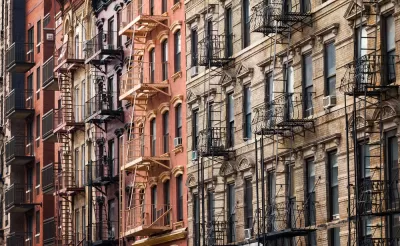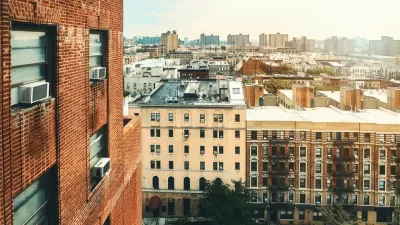Laws that control rent-stabilized apartments have been weakened over the last 25 years while the surging economy drives many of these units into the free market.

Kim Barker, a Metro desk reporter for The New York Times, paints a grim picture of the one million rent-stabilized apartments in New York City, "the city’s largest stock of affordable housing, where rents are set at a prescribed level and are supposed to increase only a small amount each year." Barker refers to them as rent-regulated, a term that includes a much smaller group of "highly coveted rent-controlled apartments [that] still exist in some pockets of the city," writes Emily Nonko of Curbed New York.
Rent stabilization generally applies to privately owned buildings containing at least six units built before 1974, according to the Metropolitan Council on Housing.
"These apartments — seen as the scourge of landlords and the salvation of struggling New Yorkers — are at the center of a housing crisis that has swelled the ranks of the homeless and threatens to squeeze all but the affluent from ever-wider swaths of the city," writes Barker, an investigative journalist, in a deep dive into what's gone wrong with rent-stabilization in New York City, "the nation’s largest rent-regulation system."
"Since 1994, at least 152,147 units were registered with the New York State Homes and Community Renewal as being deregulated due to High-Rent Vacancy Deregulation, 70% of which have been in Manhattan," according to a report [pdf] released last May by the New York City Rent Guidelines Board. Barker explains how high rent, ironically, results in the loss of tenant protections.
In neighborhoods already gentrified and in the throes of gentrifying, a relatively new class of mega-landlords has driven up rents by exploiting enforcement gaps in a web of city and state agencies. By churning through enough tenants and claiming enough renovations, landlords can raise the rent enough — beyond $2,733.75 a month — to wrest an apartment from regulation’s grip and into the free market.
In addition to losses due to High Rent Vacancy Deregulation, "[a]t least 130,000 more have disappeared because of co-op and condo conversions, expiring tax breaks and other factors," adds Barker. "And while government officials say the losses have slowed, even regulated apartments are becoming increasingly unaffordable."
One of the main weaknesses of the rent stabilization program is that the "regulatory apparatus is fractionalized, divided among three city and state agencies," explains Barker. "At the same time, the city’s housing court mired in chaos, cannot reliably weed out frivolous and abusive lawsuits."
In place of regulatory muscle, The Times found, the system relies on trust: trust that landlords do the right thing, trust that architects and engineers submit accurate permit applications, trust that landlords report rental histories correctly, trust that eviction suits are legitimate.
One finding of The Times investigation was how an apartment building in Harlem containing 66 units on 11 floors has changed due to tenants moving out (rents can increase 20 percent) and renovations. In 1996, the entire building was regulated, with both stabilized and controlled units. The average rent for the former was about $870 per month, adjusted for inflation.
By 2018, 19 units (29 percent) had been "lost to the free market." Average rent for the stabilized units was $1,218, while the market-rate units were over three times as much, $3,875.
When buildings change hands
Problems for tenants often occur when buildings are sold to corporate landlords who seek to "unlock the value" of the regulated units.
To breach the $2,733.75 threshold, mega-landlords and aspiring ones tend to follow the same playbook: After buying a building, they try to get tenants in regulated apartments to leave, often offering buyouts or harassing them with poor services or eviction suits. Once an apartment is empty, they tack on allowed vacancy increases. They often also perform renovations, enabling them to raise the rent even further while annoying remaining neighbors,B sometimes to the point of prompting them to leave.
Barker provides many examples of how landlords, using shady practices, force long-term tenants to leave their apartments, and generally get away with it because of lax regulations. The article is a long, and sadly depressing read on the state of tenant protections in New York City.
FULL STORY: Behind New York’s Housing Crisis: Weakened Laws and Fragmented Regulation

Maui's Vacation Rental Debate Turns Ugly
Verbal attacks, misinformation campaigns and fistfights plague a high-stakes debate to convert thousands of vacation rentals into long-term housing.

Planetizen Federal Action Tracker
A weekly monitor of how Trump’s orders and actions are impacting planners and planning in America.

In Urban Planning, AI Prompting Could be the New Design Thinking
Creativity has long been key to great urban design. What if we see AI as our new creative partner?

San Francisco Mayor Backtracks on Homelessness Goal
Mayor Dan Lurie ran on a promise to build 1,500 additional shelter beds in the city, complete with supportive services. Now, his office says they are “shifting strategy” to focus on prevention and mental health treatment.

How Trump's HUD Budget Proposal Would Harm Homelessness Response
Experts say the change to the HUD budget would make it more difficult to identify people who are homeless and connect them with services, and to prevent homelessness.

The Vast Potential of the Right-of-Way
One writer argues that the space between two building faces is the most important element of the built environment.
Urban Design for Planners 1: Software Tools
This six-course series explores essential urban design concepts using open source software and equips planners with the tools they need to participate fully in the urban design process.
Planning for Universal Design
Learn the tools for implementing Universal Design in planning regulations.
Gallatin County Department of Planning & Community Development
Heyer Gruel & Associates PA
JM Goldson LLC
Mpact (founded as Rail~Volution)
City of Camden Redevelopment Agency
City of Astoria
Jefferson Parish Government
Camden Redevelopment Agency
City of Claremont





























